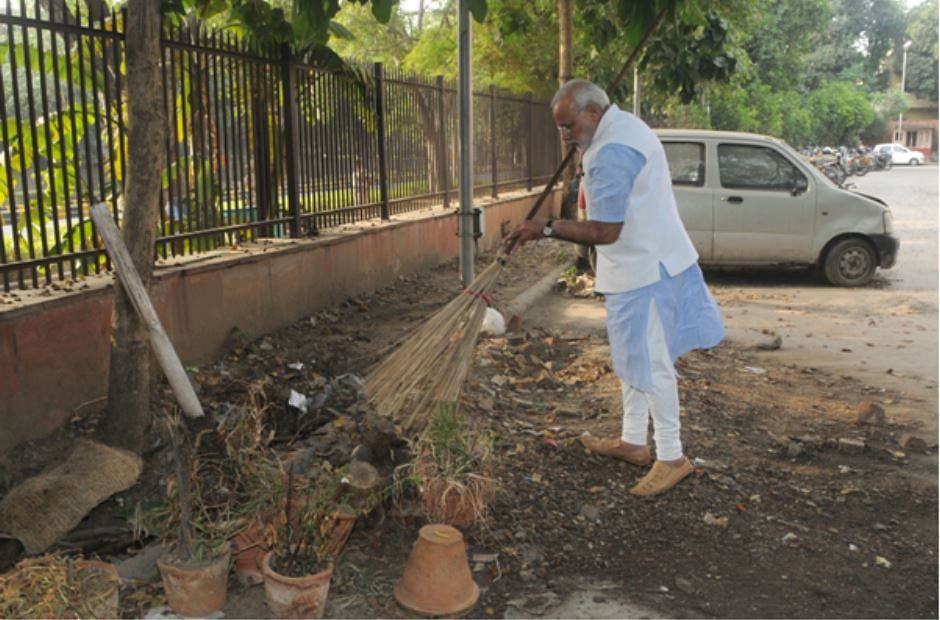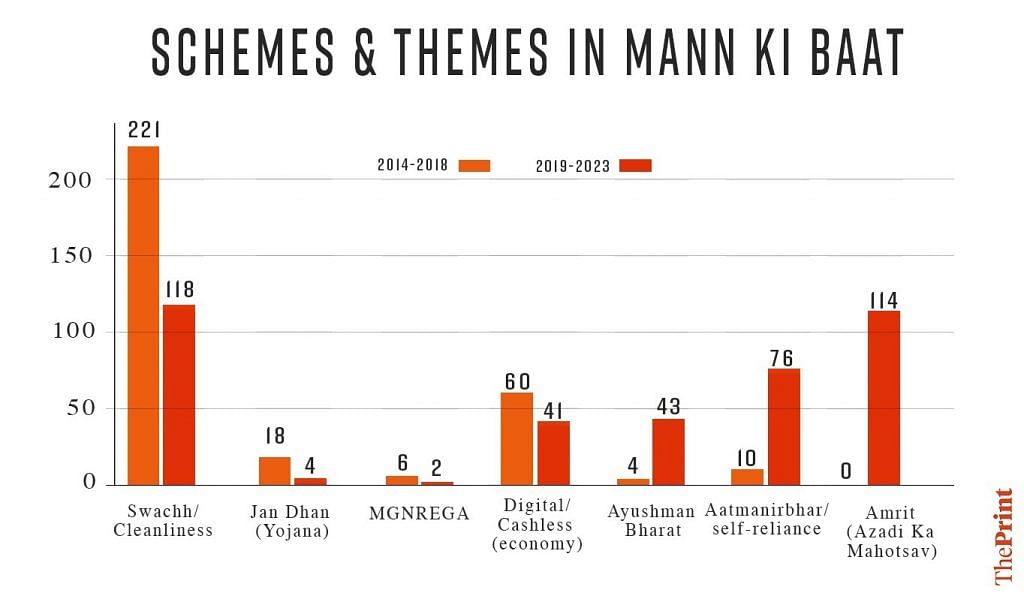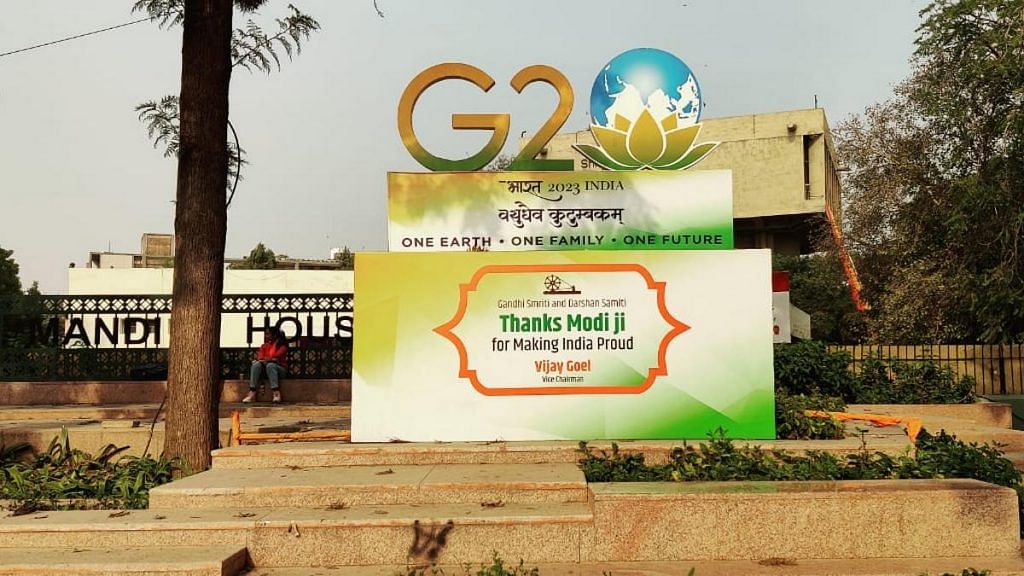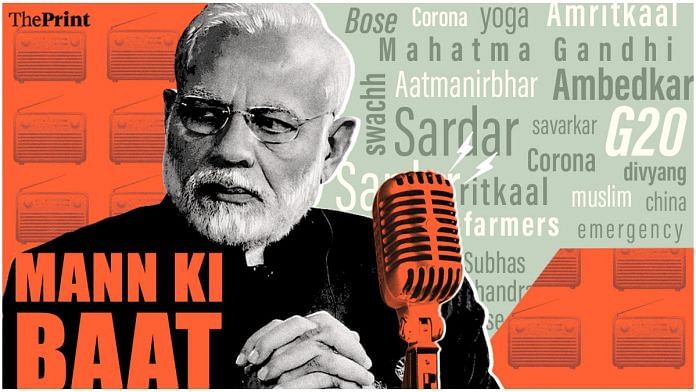New Delhi: Prime Minister Narendra Modi’s radio show Mann ki Baat has been lauded as a ground-breaking mass outreach programme and criticised as a “monthly monologue” since its October 2014 debut. But despite the mixed reviews, the show has remained a mainstay on the airwaves throughout Modi’s two terms in office, offering him a platform to connect with crores of citizens on the government’s vision, schemes, and numerous topics of public interest.
As Mann ki Baat approaches its 100th episode on 30 April, ThePrint analysed the transcripts and recordings of all previous 99 broadcasts to identify recurring themes, changes in the show’s topics over the years, and what these trends reveal about the PM’s messaging.
The analysis revealed some notable patterns in the PM’s emphasis on different schemes, framing of current affairs, and mentions of historical figures.
For instance, Mahatma Gandhi was the most frequently invoked leader over the years, with words referencing him (like Bapu and Gandhiji) being uttered 255 times over the show’s 99 episodes.
In contrast, India’s first Prime Minister Jawaharlal Nehru was mentioned only four times, usually in passing. Hindu Mahasabha leader Veer Savarkar, on the other hand, was mentioned 21 times.
In the case of the Covid pandemic, the word “corona” was mentioned 232 times, starting from March 2020. However, the more controversial word “lockdown” was mentioned only 34 times in the same 2020-23 period.
Over the two terms of the Modi government, different government schemes have received airtime on Mann ki Baat
The most mentioned scheme overall was Modi’s pet project, the Swachh Bharat Mission, a flagship sanitation programme launched in 2014. Swachhata and other words denoting cleanliness were mentioned 339 times across all 99 episodes. However, while such words came up 221 times in 2014-2018, it was down to 118 in 2019-2024.

Similarly, the financial inclusion scheme Jan Dhan Yojana, also launched in 2014, was mentioned 18 times during Modi’s first term, but only once in the subsequent four years.
Dr. Guru Prakash Paswan, a lawyer and spokesperson for the BJP, told ThePrint that Mann ki Baat serves as a platform for connecting with people at the grassroots level and understanding their issues and perspectives. If certain topics, such as swachhata, are discussed frequently, he said, it is because they have made a positive impact on the ground.
“Over the course of the show, people from all over India, including the northeast and south, have written letters to the PM in large numbers. They have shared ideas and concerns about culture, sustainability, civilisation. This exercise has been really good in presenting local perspectives on a national level,” he said.
However, Pawan Khera, chairman of the media department of the Congress, claimed that the show’s reach was questionable, pointing to a 2022 Lokniti-CSDS media survey report, which found that three-fifths of over 7,000 respondents reported never having listened to the show at all, and only one in 10 stating that they tuned in regularly.
“India has a civilisational tradition of dialogue. Repeated monologues, despite being force-telecast every month, do not seem to have many takers,” Khera said.
Mann ki Baat, usually aired on the last Sunday of every month, is broadcast across the All India Radio (AIR) network, as well as dozens of Doordarshan and private satellite channels. Viewers can also watch the show in various languages on YouTube.
According to the latest available government data, the show reached 14.3 crore people in 2020, with a viewership of 11.8 crore.
Also read: What is the ‘Jan Dhan Account-Aadhaar-Mobile’ trinity & has it aided India’s war on poverty?
From swachhata to amrit
As might be expected, PM Modi spoke more frequently about government schemes closer to their time of launch, with mentions generally ebbing over time.
Swachh Bharat and Jan Dhan Yojana, both launched in 2014, came up 221 and 18 times respectively during the first term of the NDA government. In 2019-2023, these were mentioned 118 times and once respectively.
Launched in July 2015, the Digital India programme saw a surge in mentions following the announcement of demonetisation in November 2016.
Specifically, the term was used 13 times in November and December 2016 in relation to the shift towards a cashless economy.
In total, Modi referenced digital payments and the cashless economy about 60 times between 2014-2018, and 41 times between 2019-2023.

During the Modi government’s second term, his focus during Mann ki Baat addresses expanded to include newer schemes like the public health insurance programme Ayushman Bharat, launched in September 2018. It was mentioned four times in 2018 and 43 times in 2019-2024.
The term aatmanirbharta (self-reliance) has been a Modi buzzword right from the start. It coalesced into a full-fledged government scheme called the Aatmanirbhar Bharat Abhiyan— a scheme to reduce dependence on imports and boost local production—in May 2020, around the time China-India border skirmishes erupted.
While the term “aatmanirbhar” was broached 10 times between 2014-2018, it came up 76 times in 2019-2023.
Another buzzword that gained Mann ki Baat traction in the Modi government’s second term was “amrit” or nectar, which become a major part of official discourse after the Azadi ka Amrit Mahotsav initiative was launched in March 2021 to commemorate 75 years of India’s independence.
That is when the word amrit debuted on Modi’s radio show and was mentioned no fewer than 114 times since, including in terms like Amrit Mahotsav, Amritkaal, Amrit Sarovar, and so on.
As for ongoing schemes that were not started by the Modi government, they were barely mentioned at all.
For instance, Modi referred to the Mahatma Gandhi National Rural Employment Guarantee Act (MGNREGA) six times between 2014-2018, twice in 2019, and then not at all subsequently.
Top ‘heroes’ in Mann ki Baat
Mahatma Gandhi, Sardar Vallabhbhai Patel, and Babasaheb Ambedkar have been the most frequently invoked nation-builders in Mann ki Baat so far— at 255, 103, and 60 mentions respectively by ThePrint’s count.
BJP’s Paswan asserted that these three icons were indispensable to the story of India due to their significant contributions. Apart from Gandhi’s contributions to the freedom struggle, Ambedkar dedicated his life to the welfare of marginalised sections, while Sardar Patel played a pivotal role in integrating the country. Their impact was so profound that the “story of India would be incomplete without them”, Paswan said.
Notably, in his broadcasts, Modi frequently associated these figures with the government’s ongoing initiatives.
Gandhi’s name, for one, was often linked to the ideal of cleanliness and Swachh Bharat. Indeed, the Swachh Bharat Mission was launched on his birth anniversary on 2 October 2014, and the day is now also celebrated as Swachh Bharat Diwas.
Meanwhile, Sardar Patel, who brought together over 500 princely states into a united India, has several times been mentioned in the same breath as schemes promoting “unity”— whether it’s the Ek Bharat, Shrestha Bharat (One India, Great India) scheme to foster cultural exchange and dialogue between different states, or the Goods and Services Tax (GST) and its driving principle of One Nation, One Tax.
As for Ambedkar, Modi rarely linked his name directly to the Dalit community, but instead mentioned him in the context of his ideas on urbanisation, self-reliance, and water resources development.
Modi mentioned Ambedkar several times while talking about concepts such as self-reliance through start-ups, the Smart City Mission for urbanisation, and the Bhim app for online transactions.
Other historical figures who have cropped up often in Modi’s speeches are Hindu ideologue Veer Savarkar (21 times) and swaraj crusader Bal Gangadhar Tilak (31 times). Deen Dayal Upadhyay, leader of the BJP progenitor Bharatiya Jana Sangh, came up 18 times, as did the revolutionary nationalist Subhas Chandra Bose.
The Nehru-Gandhi family, though, was rarely up for discussion. Jawaharlal Nehru was mentioned four times, his daughter Indira six times, and Rajiv Gandhi not at all.
The references to Indira and Nehru were brief and only during their birth or death anniversaries, unlike the other figures, who were presented as inspirations for the country.
Steering clear of controversy, China to farmers
Modi has generally given hotbutton issues, including neighbours Pakistan and China, a wide berth in Mann ki Baat.
The last time Modi spoke of Pakistan in Mann ki Baat was in July 2020, where in the context of Kargil Vijay Divas, he said the country “nursed delusions of encroaching upon Indian soil”.
As for China, Modi last mentioned it in June 2019. He observed that the number of people who voted in India exceeded the population of every other country except China.
While Modi often spoke of farmers in his show during the first term of the government, but somewhat less so during the second.
Farmers were talked about 260 times during 2014-2018 and just 178 times between 2019-2023.
While Modi had extolled the benefits of three new farm laws during Mann ki Baat in November 2020, he did not mention the ongoing protests by farmers. He was also silent about the subsequent withdrawal of the three laws in 2021.
Criticism of opposition
Modi has indirectly criticised the opposition on multiple occasions in his Mann ki Baat broadcasts.
In February 2018, for instance, he stressed how electricity could reach three villages of Maharashtra’s Elephanta island “only after 70 years of independence”.
At other times, he has been more direct. For example, in March 2015, he lobbied for his government’s farm policies while also accusing the Congress for giving farmers less compensation than promised for land in two states that had been ruled by the party.
It is worth noting that between 2014 and 2018, Modi mentioned the Emergency under Indira Gandhi five times, primarily referring to its “sinister shadows” on democracy during its anniversary in June.
However, just ahead of Lok Sabha elections, he used the term as many as six times in just one month, February 2019.
Speaking of polls, PM Modi has mentioned the Election Commission (EC) 13 times in all, always in complimentary terms. Nine of these mentions were in the 2019 election year.
Also read: ‘Legend, creative disruptor, statesman’ — how an entire genre of books has grown around PM Modi
‘Marginalised’ sections, Dalits to ‘divyang’
In Mann ki Baat, Modi has mentioned Dalits and Muslims only 10 and nine times respectively.
These references were not in relation to these communities’ struggles, but rather in the context of individual cases of success, such as the construction of toilets in their villages.
The PM did, however, use the word underprivileged and its synonyms 32 times.
Asked about this BJP’s Paswan said that when the PM mentions such terms, it encompasses any disadvantaged section of society.
“When the word underprivileged or deprived is used, it covers everyone. It includes all sections: SC, ST, OBC, differently abled, and others. When you see the definition of deprived or disadvantaged, it is a large inclusive group. Personally, I think it doesn’t matter. When your focus is on development or policy imperatives that benefit those classes, and if they have voted and showed support, it is a testament to the party’s commitment to them,” he said.
Nevertheless, disability has been given targeted attention, with PM Modi referring to “divyang” and the “differently abled” at least 73 times during the course of the show.
Yen for yoga, G20 on the rise
PM Modi has constantly advocated for yoga and mentioned it no fewer than 344 times on Mann ki Baat, expounding on its role in “preventative healthcare” and how it can help “fight diabetes”.
He has also celebrated the “internationalisation of yoga”, including the United Nations dedicating a day to it.
In a similar congratulatory vein about India’s international standing, the show has highlighted several instances where the world was ostensibly impressed by India. These included the “highest Foreign Direct Investment (FDI)”, successful evacuation efforts in disaster-hit areas, the successful launch of 104 satellites, and the indigenous Covid vaccine.

Notably, in January 2015, former US President Barack Obama became the only first (and only) guest to physically appear on the show.
Moreover, ever since India assumed the Group of 20 presidency last December, the term “G20” has already been used 21 times on the radio show.
With the G20 summit in September drawing closer, the focus on it will likely increase in the coming episodes.
‘More propaganda than presence over time’
According to political analysts that ThePrint spoke to, Mann ki Baat has helped burnish the government’s image, but the show lacks substance.
Academic and social scientist Shiv Visvanathan, for instance, said Modi has pulled off a “tremendous use of symbols” in his discourses on subjects like yoga, but there are no novel insights.
“It is a mirror on the wall performance. Media in anyone’s hand today makes them look monumental… Modi represents what I call the official tutorial college nation,” Visvanathan argued.
Khera, too, said that the show represented “nine years” of hype, but not much substance.
Asked about shifts in the show’s themes and tone over the last two terms of the government, Visvanathan said he believed the first phase was more grounded and had more “physicality” to it.
As for shows in the government’s second term — during which India faced challenges like the pandemic and its economic effects — Modi presented himself as “nursing the soul of the nation”, Visvanathan said.
“Modi’s power is convincing, but his imagination in the second phase is quite empty. He represents straitjacketed nationalism. What is impressive is he has turned his speeches into rituals conveying a magical power… but that is more propaganda than presence,” he added.
BJP’s Paswan, however, maintained that Modi’s emphasis on government schemes helped garner more public participation and also built civic awareness in the country.
(Edited by Asavari Singh)
Also read: Modi as ‘lovable king’ who ‘dared to dream’ — Delhi exhibition captures PM’s journey on canvas



